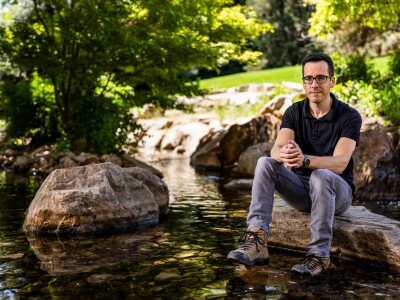BYU researcher uncovers partnership between jazz icon Louis Armstrong and eccentric dancers
The hit television show "Dancing with the Stars" has been around only a few years, but a new study by a Brigham Young University researcher shows that a different type of dancing with the stars happening in the late 1920s may have shaped jazz music as we know it.
In an article appearing in the current issue of the Journal of the American Musicological Society, music professor Brian Harker shows that a partnership with a jittering, jiving, dancing duo may have heavily influenced the rhythms of Louis Armstrong, widely recognized as one of the most influential jazz musicians of all time.
Harker's article provides evidence that Armstrong's jazz trumpeting actually took on a more free flowing, innovative and flexible style due to his performing duets with the dancers.
"The dancing seems to have pushed jazz in a new direction," said Harker, who notes that dance's role in the development of early jazz music has not been well understood.
Between the summer of 1926 and the summer of 1927, Armstrong entered into a partnership at Chicago's Sunset Café with a husband-and-wife dance team called Brown and McGraw. Armstrong played his trumpet onstage with the dancers, playing rehearsed--though not written--solos that closely matched their steps, movements or facial expressions.
"This couple introduced rhythmic dance movements to Armstrong, which opened up the way to more complicated dance steps," Harker said. "And the rhythm of those steps may have changed the way Armstrong performed himself."
During the time of their musical collaboration, Armstrong retuned his approach to rhythm. Whereas previously he tended to rely on more or less fixed rhythms, his recordings in late 1926 and 1927 reveal a style that is free and flexible. This rhythm became the foundation for the new jazz language that emerged in the Swing Era.
"For Harker to be able to piece together what the eccentric dance of the time was like and how it influenced a major player at a turning point in jazz history is truly remarkable," said Kate van Orden, editor for the Journal of the American Musicological Society and professor of music at the University of California-Berkeley. "It's masterful work in every respect - its methodological conception, archival research, music analysis and presentation."
Harker uncovered this little known partnership between Armstrong and Brown and McGraw during a research sabbatical in New York City in 2005 and 2006. While digging through an interview with a trumpet player named Doc Cheatham, Harker found references to this partnership. From there, Harker went on a treasure hunt and found additional sources from newspapers, clippings in Armstrong's scrapbooks, census records and a 1926 court case between Brown and McGraw and a club in which they performed. Harker also tracked down a living nephew of the dancing couple who provided additional personal information.
Harker learned that Armstrong not only accompanied the duo, but he also worked out solos based on their dancing. "Big Butter and Egg Man" is one such solo that may have been influenced in this way.
A quote from Armstrong on the collaboration is cited in the paper: "There was the team of Brown and McGraw -- they did a jazz dance that just wouldn't quit. I'd blow for their act, and every step they made, I put the notes to it."
Harker said this finding led to the discovery of other examples of jazz trumpet soloists not only working with dancers, but also getting on stages and performing along with them.
It took the BYU researcher two years to harmonize the research and write the paper. It includes the first scholarly writings about Brown and McGraw, a duo that faded out when they couldn't translate their act to movies and radio.
This is not the first time Harker has researched Armstrong. The music history and theory professor, who also plays the jazz trumpet, first started studying Armstrong while working on his Ph.D. dissertation. He won the 1999 Irving Lowens Award for his article, "'Telling a Story': Louis Armstrong and Coherence in Early Jazz," published by Current Musicology.






